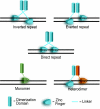A fungal family of transcriptional regulators: the zinc cluster proteins
- PMID: 16959962
- PMCID: PMC1594591
- DOI: 10.1128/MMBR.00015-06
A fungal family of transcriptional regulators: the zinc cluster proteins
Abstract
The trace element zinc is required for proper functioning of a large number of proteins, including various enzymes. However, most zinc-containing proteins are transcription factors capable of binding DNA and are named zinc finger proteins. They form one of the largest families of transcriptional regulators and are categorized into various classes according to zinc-binding motifs. This review focuses on one class of zinc finger proteins called zinc cluster (or binuclear) proteins. Members of this family are exclusively fungal and possess the well-conserved motif CysX(2)CysX(6)CysX(5-12)CysX(2)CysX(6-8)Cys. The cysteine residues bind to two zinc atoms, which coordinate folding of the domain involved in DNA recognition. The first- and best-studied zinc cluster protein is Gal4p, a transcriptional activator of genes involved in the catabolism of galactose in the budding yeast Saccharomyces cerevisiae. Since the discovery of Gal4p, many other zinc cluster proteins have been characterized; they function in a wide range of processes, including primary and secondary metabolism and meiosis. Other roles include regulation of genes involved in the stress response as well as pleiotropic drug resistance, as demonstrated in budding yeast and in human fungal pathogens. With the number of characterized zinc cluster proteins growing rapidly, it is becoming more and more apparent that they are important regulators of fungal physiology.
Figures





References
-
- Abe, Y., C. Ono, M. Hosobuchi, and H. Yoshikawa. 2002. Functional analysis of mlcR, a regulatory gene for ML-236B (compactin) biosynthesis in Penicillium citrinum. Mol. Genet. Genomics 268:352-361. - PubMed
-
- Akache, B., S. MacPherson, M. A. Sylvain, and B. Turcotte. 2004. Complex interplay among regulators of drug resistance genes in Saccharomyces cerevisiae. J. Biol. Chem. 279:27855-27860. - PubMed
-
- Akache, B., and B. Turcotte. 2002. New regulators of drug sensitivity in the family of yeast zinc cluster proteins. J. Biol. Chem. 277:21254-21260. - PubMed
Publication types
MeSH terms
Substances
LinkOut - more resources
Full Text Sources
Other Literature Sources
Molecular Biology Databases

